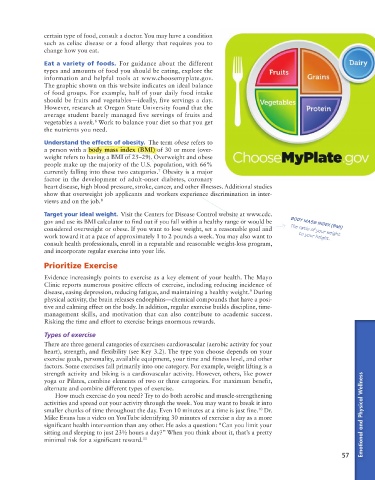Page 94 - Keys to College Success
P. 94
certain type of food, consult a doctor. You may have a condition
such as celiac disease or a food allergy that requires you to
change how you eat.
Eat a variety of foods. For guidance about the different
types and amounts of food you should be eating, explore the
information and helpful tools at www.choosemyplate.gov.
The graphic shown on this website indicates an ideal balance
of food groups. For example, half of your daily food intake
should be fruits and vegetables—ideally, five servings a day.
However, research at Oregon State University found that the
average student barely managed five servings of fruits and
vegetables a week. Work to balance your diet so that you get
6
the nutrients you need.
Understand the effects of obesity. The term obese refers to
a person with a body mass index (BMI) of 30 or more (over-
weight refers to having a BMI of 25–29). Overweight and obese
people make up the majority of the U.S. population, with 66%
currently falling into these two categories. Obesity is a major
7
factor in the development of adult-onset diabetes, coronary
heart disease, high blood pressure, stroke, cancer, and other illnesses. Additional studies
show that overweight job applicants and workers experience discrimination in inter-
views and on the job. 8
Target your ideal weight. Visit the Centers for Disease Control website at www.cdc.
gov and use its BMI calculator to find out if you fall within a healthy range or would be BODY MASS INDEX (BMI)
considered overweight or obese. If you want to lose weight, set a reasonable goal and The ratio of your weight
work toward it at a pace of approximately 1 to 2 pounds a week. You may also want to to your height.
consult health professionals, enroll in a reputable and reasonable weight-loss program,
and incorporate regular exercise into your life.
Prioritize Exercise
Evidence increasingly points to exercise as a key element of your health. The Mayo
Clinic reports numerous positive effects of exercise, including reducing incidence of
disease, easing depression, reducing fatigue, and maintaining a healthy weight. During
9
physical activity, the brain releases endorphins—chemical compounds that have a posi-
tive and calming effect on the body. In addition, regular exercise builds discipline, time-
management skills, and motivation that can also contribute to academic success.
Risking the time and effort to exercise brings enormous rewards.
Types of exercise
There are three general categories of exercises: cardiovascular (aerobic activity for your
heart), strength, and flexibility (see Key 3.2). The type you choose depends on your
exercise goals, personality, available equipment, your time and fitness level, and other
factors. Some exercises fall primarily into one category. For example, weight lifting is a
strength activity and biking is a cardiovascular activity. However, others, like power
yoga or Pilates, combine elements of two or three categories. For maximum benefit,
alternate and combine different types of exercise.
How much exercise do you need? Try to do both aerobic and muscle-strengthening
activities and spread out your activity through the week. You may want to break it into
smaller chunks of time throughout the day. Even 10 minutes at a time is just fine. Dr.
10
Mike Evans has a video on YouTube identifying 30 minutes of exercise a day as a more Emotional and Physical Wellness
significant health intervention than any other. He asks a question: “Can you limit your
sitting and sleeping to just 23½ hours a day?” When you think about it, that’s a pretty
minimal risk for a significant reward. 11
57

